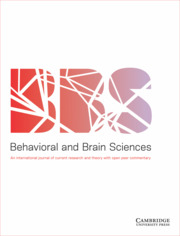Article contents
Brain mechanisms of acoustic communication in humans and nonhuman primates: An evolutionary perspective
Published online by Cambridge University Press: 15 May 2014
Abstract
Any account of “what is special about the human brain” (Passingham 2008) must specify the neural basis of our unique ability to produce speech and delineate how these remarkable motor capabilities could have emerged in our hominin ancestors. Clinical data suggest that the basal ganglia provide a platform for the integration of primate-general mechanisms of acoustic communication with the faculty of articulate speech in humans. Furthermore, neurobiological and paleoanthropological data point at a two-stage model of the phylogenetic evolution of this crucial prerequisite of spoken language: (i) monosynaptic refinement of the projections of motor cortex to the brainstem nuclei that steer laryngeal muscles, presumably, as part of a “phylogenetic trend” associated with increasing brain size during hominin evolution; (ii) subsequent vocal-laryngeal elaboration of cortico-basal ganglia circuitries, driven by human-specific FOXP2 mutations.;>This concept implies vocal continuity of spoken language evolution at the motor level, elucidating the deep entrenchment of articulate speech into a “nonverbal matrix” (Ingold 1994), which is not accounted for by gestural-origin theories. Moreover, it provides a solution to the question for the adaptive value of the “first word” (Bickerton 2009) since even the earliest and most simple verbal utterances must have increased the versatility of vocal displays afforded by the preceding elaboration of monosynaptic corticobulbar tracts, giving rise to enhanced social cooperation and prestige. At the ontogenetic level, the proposed model assumes age-dependent interactions between the basal ganglia and their cortical targets, similar to vocal learning in some songbirds. In this view, the emergence of articulate speech builds on the “renaissance” of an ancient organizational principle and, hence, may represent an example of “evolutionary tinkering” (Jacob 1977).
Keywords
Information
- Type
- Target Article
- Information
- Copyright
- Copyright © Cambridge University Press 2014
References
- 159
- Cited by


Target article
Brain mechanisms of acoustic communication in humans and nonhuman primates: An evolutionary perspective
Related commentaries (30)
Beyond cry and laugh: Toward a multilevel model of language production
Comparative analyses of speech and language converge on birds
Contribution of the basal ganglia to spoken language: Is speech production like the other motor skills?
Differences in auditory timing between human and nonhuman primates
Does it talk the talk? On the role of basal ganglia in emotive speech processing
Early human communication helps in understanding language evolution
En route to disentangle the impact and neurobiological substrates of early vocalizations: Learning from Rett syndrome
Environments organize the verbal brain
Evolution of affective and linguistic disambiguation under social eavesdropping pressures
Functional neuroimaging of human vocalizations and affective speech
Functions of the cortico-basal ganglia circuits for spoken language may extend beyond emotional-affective modulation in adults
Modification of spectral features by nonhuman primates
Neanderthals did speak, but FOXP2 doesn't prove it
Perceptual elements in brain mechanisms of acoustic communication in humans and nonhuman primates
Phonation takes precedence over articulation in development as well as evolution of language
Physical mechanisms may be as important as brain mechanisms in evolution of speech
Speech as a breakthrough signaling resource in the cognitive evolution of biological complex adaptive systems
Speech prosody, reward, and the corticobulbar system: An integrative perspective
Speech, vocal production learning, and the comparative method
The basal ganglia within a cognitive system in birds and mammals
The evolution of coordinated vocalizations before language
The forgotten role of consonant-like calls in theories of speech evolution
The sensorimotor and social sides of the architecture of speech
The sound of one hand clapping: Overdetermination and the pansensory nature of communication
Very young infants' responses to human and nonhuman primate vocalizations
Vocal communication is multi-sensorimotor coordination within and between individuals
Vocal learning, prosody, and basal ganglia: Don't underestimate their complexity1
Voluntary and involuntary processes affect the production of verbal and non-verbal signals by the human voice
Why vocal production of atypical sounds in apes and its cerebral correlates have a lot to say about the origin of language
Why we can talk, debate, and change our minds: Neural circuits, basal ganglia operations, and transcriptional factors
Author response
Phylogenetic reorganization of the basal ganglia: A necessary, but not the only, bridge over a primate Rubicon of acoustic communication